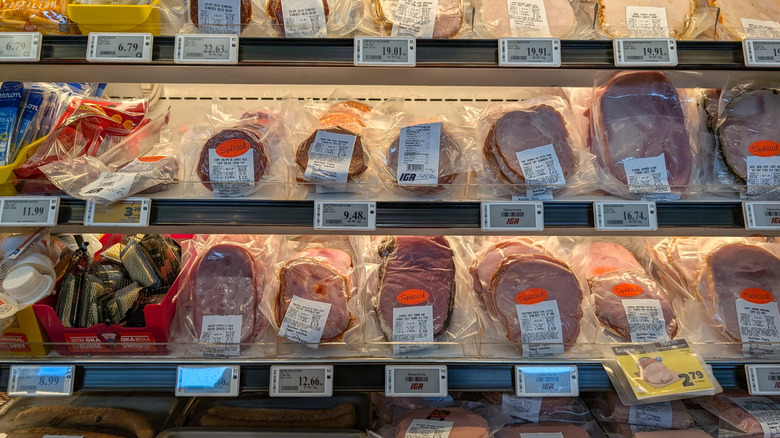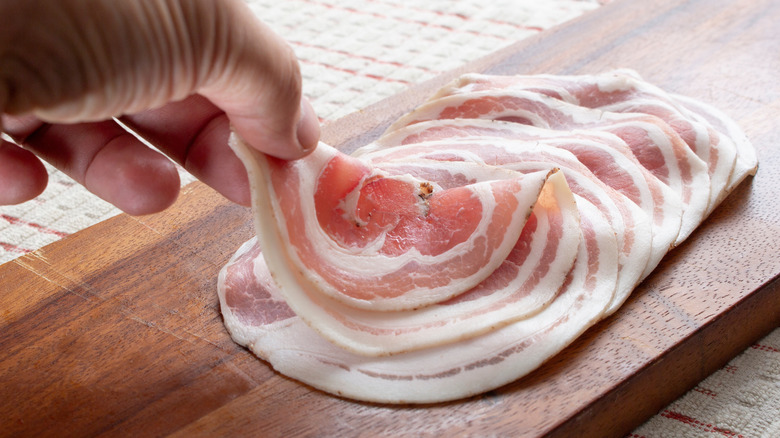The Healthiest Deli Meats And What Makes Them The Better Choice
There's no denying that Americans love their deli meat. In fact, in 2024, deli food sales in North America totaled roughly $112 billion, with cold cuts and cured meats accounting for almost 38% of the processed meats intake in U.S. diets. From layering them in sandwiches, eating them as snacks, or fancying them up on a charcuterie board, deli meats tick all the boxes of convenience, budget-friendliness, and most importantly, taste. But, as much as they are loved, there is increasing research to show that not all deli meats are created equal. Some can be enjoyed more frequently, while others should be saved for sporadic treats. To help us decide which deli meats are healthiest, we consulted two experts in nutrition and healthy living.
Lisa Richards is a nutritionist, published author, and creator of The Candida Diet. With over 20 years of research and writing on gut health, she has built a significant global audience. Together with Dr. Eric Wood, she developed the Ultimate Candida Diet program, a plan designed to restore balance to your life through diet, probiotics, and natural antifungals. We also spoke with Rena Awada, the founder of Healthy Fitness Meals, a popular food platform dedicated to wholesome, family-friendly recipes. Originally from Sierra Leone and now based in Detroit, Rena brings several decades of cooking experience to her work. As a busy mother of five, she understands the challenge of making meals that are both nourishing and practical. Together, our experts' insights shed light on how to choose the healthiest deli meats.
What makes a deli meat healthy?
Deli meats are some of the most popular products in the global market, accounting for a significant share of U.S. meat consumption. Many of us grew up on school lunches consisting of bologna sandwiches, but of late, thanks to the proliferation of recalls and warnings from scientific and government agencies, one has to pause and pay heed to what these worrying reports have to say. Including increased risks of heart disease, cancer, and diabetes, eating deli meats can even feel like a risky option. While the FDA recommends a daily limit of 2,300 milligrams of sodium, a regular deli sandwich can easily clock in a large portion of this maximum. According to the CDC, excess sodium intake is directly related to diseases such as high blood pressure and stroke. Similarly, the chemical additives, salt, and high fats in some deli meats have been linked to increased risks for cancer.
We have to wonder, is there such a thing as a healthy or least-processed deli meat? As Lisa Richards explains, "Healthier choices of deli meats include lower sodium options with minimal processing and fewer additives." According to Rena Awada, "The factors I look for ... are the amount of sodium it has, if it is minimally processed, if it has added nitrates or nitrites, the type of meat that's being used, and whether it has a lot of additives and fillers."
How to read labels and spot better choices
Sometimes reading the nutrition label feels like you need a degree in chemistry. However, all it takes is a bit of patience, curiosity, and a healthy dose of caution to cut through the fluff and find out the truth. Lisa Richards explains, "A shorter ingredients list is one of the best indicators of a healthier deli meat." When it comes to processed meats, a proposed FDA food packaging change could even make choosing healthy options easier, since key nutrition facts would be listed on the front. You should also consider the serving size (since it's often smaller than you'd expect) and the calorie count.
Other labels to take note of include "organic," "natural," and "healthy." For instance, the "organic" label can be very confusing since the USDA considers many products worthy of certification. Some rules specify how the animals are raised, but the items can technically contain up to 5% of non-organic ingredients. "Natural" should mean minimal processing, but the Department of Agriculture doesn't specify if this refers to the curing process as well. Similarly, "healthy" may mean low in fat, but it can conveniently ignore other health risks associated with deli meats. Rena Awada adds, "For some healthier options, look for labels that say 'nitrate-free' or 'no added nitrates/nitrites'. Also, look at the amount of sodium the deli meat has. I also look for labels that say low or 'reduced sodium'. The recommendation is 140 milligrams of sodium or less."
Turkey Breast: The Lean Standard
Now, let's get into the deli meats in detail, starting with one of the healthiest options — turkey breast. Rena Awada notes, "Deli meat made of turkey breast, especially if it says roasted turkey breast, is one of the healthiest options out there." Lisa Richards adds, "Turkey breast is generally a leaner and lower calorie deli meat option, lower in fat, and higher quality protein." This means it can help keep you full without feeling sluggish. Turkey breast also works well for those on a high-protein or keto diet. Makes you wonder why turkey isn't found in more fast food outlets, right? If you are limiting your carb intake, avoid bread and wraps, and instead, serve turkey breast as part of a charcuterie board or shred it into a salad. To beef up your meal, consider using low-carb or egg wraps as lighter alternatives.
Not all turkey breast meat is the same, though. Awada advises, "I would still look at the label to see if it is low in sodium, and if there are any unnecessary additives and preservatives." Used to enhance a product's shelf life or flavor, some common ingredients that you might want to watch out for include corn syrup or starches. Ideally, look for labels such as "roasted turkey breasts" versus "turkey loaf", keeping you as close to the whole product as possible.
Chicken Breast: Versatile and Protein-packed
Chicken breast is another go-to choice for those seeking a healthier deli meat. Adding minimally processed chicken breast to your diet is one of the easiest ways to meet your daily protein requirements. It's usually lower in saturated fat and less processed than other deli meats, making it a healthier alternative. Rena Awada explains that chicken is pretty similar to turkey. "Turkey breast will be a bit leaner and lower in calories when compared to the chicken breast option," she explains. "Processed deli turkey may have a bit more sodium than the chicken option, while the chicken option may be a bit more flavorful than the turkey option."
For a while now, marketing and advertising have been pushing the agenda of high-protein foods as the silver bullet for good health. However, like any vitamin or nutrient, moderation is key. By all means, add sliced chicken breast to your daily menu, but balance it out with fresh vegetables and some form of carbs in every meal. The recommended serving size of chicken breast is 3 to 4 ounces per meal. That's about a palmful of meat. Darker cuts like thighs and legs are higher in fat and calories, while white meat is a healthier choice. And remember, what you pair the chicken with also matters. Drowning the healthier deli meat in salad dressing or a creamy sauce could send the nutrition facts out of whack.
Roast Beef: A Red Meat Option with Balance
For years now, we've been led to believe that beef is bad for our health, but recent research is more nuanced. A 3-ounce serving of roast beef has 21 grams of protein and is also a great source of numerous vitamins and minerals, such as iron, zinc, and vitamin B12. However, the type of cut and how the animal has been raised have plenty of impact on the meat's nutrition.
"Deli cuts made of roast beef are higher in fat and calories when compared to poultry-based options," Rena Awada cautions. Lisa Richards adds, "For those needing more iron and zinc, roast beef has a higher content of those minerals. However, it is often higher in fat and sodium than either chicken or turkey." Awada sums it up with an important question: "But is it worth the swap? Choosing a roast beef option will have 2-4 times more fat than a chicken or turkey option." If you absolutely can't stay away from deli roast beef, proceed with moderation. You can chop up and mix deli roast beef with fixings as a tasty spread for sandwiches, or add it over a green salad. It would also work in a stir-fry packed with veggies for balance, or in a noodle bowl for an Asian-inspired meal. Another option is to make deli-style roast beef at home, allowing you complete control over the salt levels and preservatives.
Ham: When to Choose and When to Skip
If we were forced to choose between deli meats based purely on protein levels, saturated fat, and calories, then ham would fall squarely on the "healthy" side. According to Healthline, 2 ounces of deli ham contains approximately 61 calories and 9.5 grams of protein, making for a nutritious addition to your sandwich or quick snack on the go. Ham is also known to be an excellent source of selenium and essential amino acids, along with iron, zinc, and B vitamins.
However, it's not always clear how to choose ham at the store. Its nutritional benefits depend on how the animal was raised and what curing method was used. Deli ham is typically made from the pig's leg, and the main methods of processing it are dry-curing or wet-curing. Both techniques involve adding salt to the product and leaving it to age, thereby increasing sodium levels. "Lean cuts of ham can fit into a healthy diet in moderation," says Lisa Richards. "It is higher in sodium and therefore shouldn't be combined with other high-sodium meats to prevent overconsuming of this nutrient."
Alternatively, the USDA stipulates that uncured ham must be labeled as "fresh" and contain no nitrates or nitrites. Spanish-style Iberian ham, or jamón ibérico, is considered a less risky alternative to processed hams, due to the pigs' free-roaming lifestyle and diet of acorns.
Prosciutto: Portion Control is Key
You may have noticed the almost reddish-hued, paper-thin slices of ham sold at your deli or upmarket grocery stores and wondered how to plate and enjoy prosciutto. Usually sporting a Made in Italy or DOP label, prosciutto is prized for its delicate texture and surprisingly intense flavor. It's made by following strict traditional guidelines. The meat is lightly salted and aged, resulting in a product that is neither smoked nor contains nitrates or preservatives.
Not being processed also puts prosciutto in the better-for-you section. It is relatively high in healthy fats and protein (almost 8 grams per ounce), which are two important factors for muscle recovery and brain health. Sure, it contains sodium, but it's lower in comparison to the other deli meats on offer. While figures vary, one ounce of prosciutto can contain roughly 700 milligrams of sodium, which is not a matter to ignore. As long as it's a part of a balanced meal with fruit or carbs, however, you can still enjoy this savory meat. As Lisa Richards points out, "Prosciutto should not be used as a staple source of protein, but an occasional treat due to its higher saturated fat and sodium content." In short, prosciutto is nutrient-dense, delicious, and an undeniable part of any Mediterranean diet, but at the end of the day, we have to caution against overconsumption.
Smoked Salmon: Protein and Heart Healthy Fats
Smoking salmon (among other meats) is one of the oldest ways to prevent wastage and keep food fresh for longer. Smoking not only increases the shelf life but also adds a wonderful flavor to the fish. Processed salmon is cured with salt and can be smoked using cold or hot methods.
As Rena Awada points out, "Smoked salmon is a great deli option and can be healthy when eaten in moderation, especially if they are lightly smoked and it says low sodium on it. Salmon is a lean protein option, is a great source of omega-3 fatty acids, and has some added vitamins and minerals." Salmon's omega-3 fatty acids are essential fats that help boost your brain, heart, and eye health. Awada further points out, "Smoked salmon is not what you refer to as 'ultra-processed,' but it is still considered somewhat processed since it is cured or smoked." Lisa Richards echoes this sentiment, explaining that while it's high in omega-3s, smoked salmon can also contain increased levels of sodium. If this topic has brought bagels to mind, know that there is a difference between smoked salmon and lox, and the latter is typically much saltier.
Pastrami and Corned Beef: Flavor versus Health
Given the research and our experts' input, it's pretty clear what the key takeaway is here. When it comes to any type of deli meat, balance is the name of the game. Take pastrami and corned beef, for instance. Both meats are made from beef brisket but from different cuts. Their preparation also differs. Corned beef is boiled after curing, while pastrami is smoked and steamed for a deeper flavor. As Lisa Richards notes, "Pastrami and corned beef are another example of a meat or protein source that should be enjoyed in moderation rather than a regular source of protein. They are both highly processed, leading to high levels of sodium and fat."
Nutritionally, pastrami fares slightly better with around 40 calories and 5 to 6 grams of protein per ounce. Corned beef, on the other hand, has roughly 60 calories and 4 grams of protein per ounce. The biggest factor to look out for with both of these deli meats, however, is the sodium content. Rena Awada puts it bluntly: "I personally don't consider them healthy at all and avoid them as much as possible. This is not to say others can't have them at all. In moderation and on certain occasions, why not, especially if they have it with loads of other veggies and lower-sodium items."
Bologna and Mortadella: Overprocessed and Low on Benefits
So, now we've arrived at the least healthy deli counter choices. Lisa Richards sums it up clearly: "Mortadella, bologna, and other processed sausages are high in sodium, saturated fat, and additives, all of which make them among the least healthy options of deli meat."
Bologna is made from a mix of pork and beef trimmings, which are emulsified with fat, preservatives, flavorings, and then cured. Mortadella is similar, although it only uses pork trimmings and fat. While both of these options are tasty, there's no denying that they are some of the unhealthiest deli meats available. A single slice of bologna (or about 1 ounce) contains roughly 90 calories and 200 milligrams of sodium. Mortadella often contains even more fat due to the addition of pork fat cubes. Rena Awada is even more direct: "These are what I will refer to as a once-in-a-while kind of indulgence. I would avoid them entirely if I could. They are ultra-processed, high in fat and calories, and have very high sodium and preservatives."
And the issue isn't just calories or salt. According to a study from the American Diabetes Association, the frequent or excessive consumption of processed meats has been linked to an increased risk of heart disease, type 2 diabetes, and colorectal cancer.
Are uncured deli meats really better?
You may have recently noticed a growing number of deli meats with "nitrate-free" or "uncured" labels. You might assume that these are safer or more natural choices than traditionally cured meats, right? In reality, the labels refer to how the meat has been preserved and are not necessarily indicative of lower health risks. That's because traditional curing uses sodium nitrite or nitrate to inhibit bacterial growth, extend shelf life, and maintain color. Lisa Richards explains, "Nitrate-free or uncured deli meats are likely to still contain natural nitrates, like from celery powder, so their claims at being healthier are often overinflated."
Whether synthetic or plant-based, nitrates and nitrites form nitrosamines when exposed to high heat. These are the compounds that are classified as potential carcinogens, and the excessive consumption of nitrate-containing deli meats may increase the risk of certain cancers and cardiovascular issues. Uncured meats are usually fully cooked before sale, making them safe to eat, but they are never completely risk-free. Keep in mind that it all comes down to clever marketing that gives the impression of being healthier with only minor tweaks in the internal composition. Sodium and other additives are rarely removed or reduced and therefore still carry the health concerns associated with high consumption. Ultimately, to choose the healthiest deli meats, you should focus on options that offer moderate sodium content, lean protein levels, and minimal processing.











